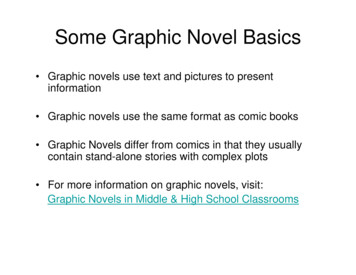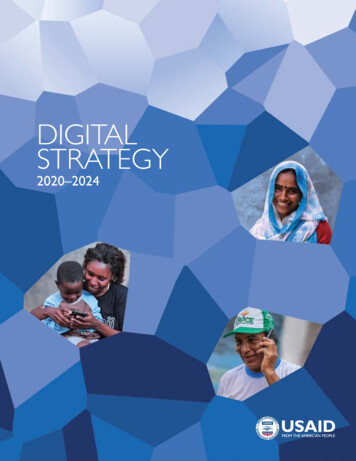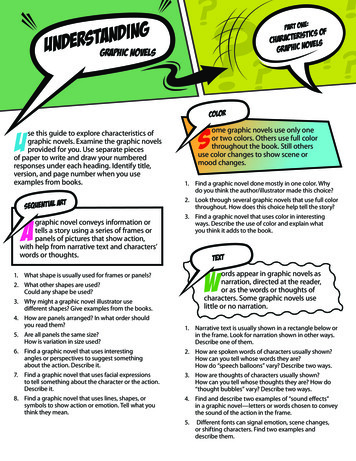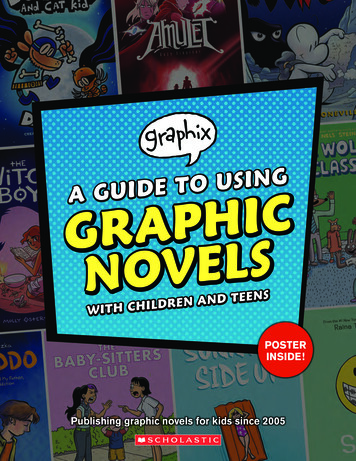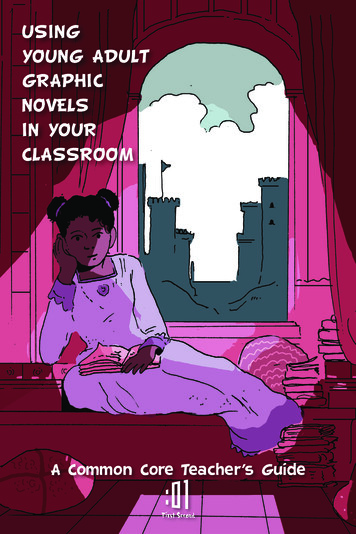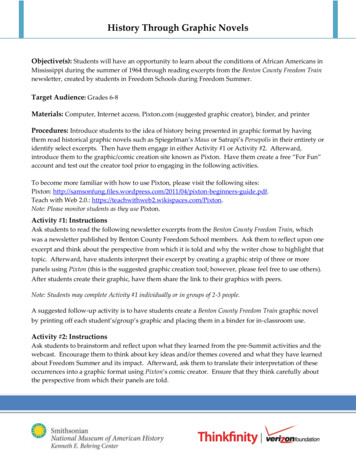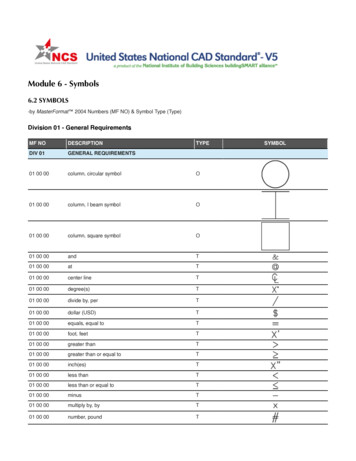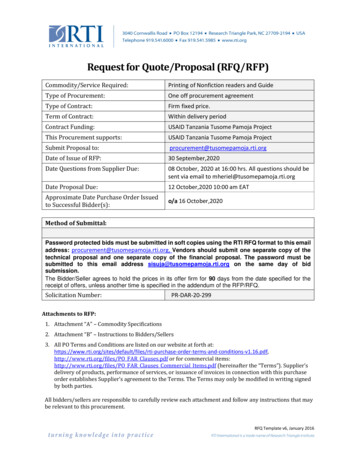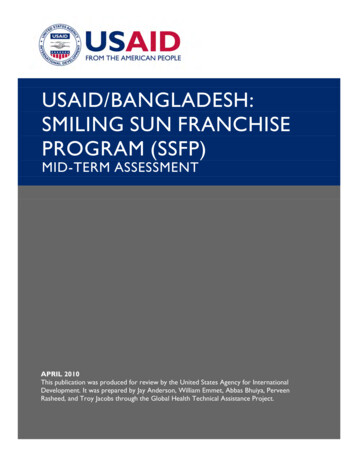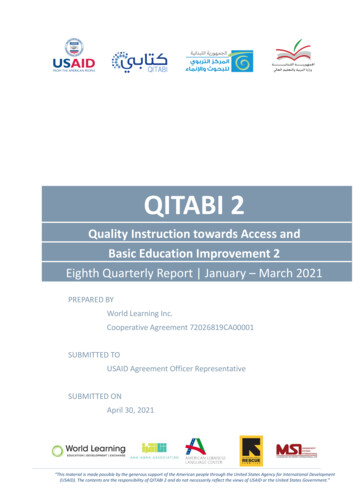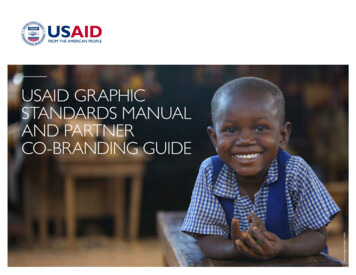
Transcription
Photo: Morgana Wingard / USAIDUSAID GRAPHICSTANDARDS MANUALAND PARTNERCO-BRANDING GUIDE
THIS MANUAL SETS THE STANDARDFOR ALL USAID COMMUNICATIONSPRODUCED BY EMPLOYEES,CONTRACTORS, GRANTEES ANDOTHER PARTNERS.This Graphic Standards Manual replaces and updates the version released in 2005.February 2016 (revised Feb 2020)I
INTRODUCTIONUSAID’s brand is more than a logo. It reflects the unique values and principlesof the Agency to a worldwide audience. And, it represents the goodwill of theAmerican people in providing assistance to those in need. We have all “earned”our brand by doing hard things well, often in the most challenging environments.We all have an important role to play in amplifying and protecting USAID’sbrand. Whether we are a mission director, contracting officer (CO), agreementofficer (AO), program specialist, implementing partner, or play another key role,the work we do each and every day contributes to our brand.This Graphic Standards Manual replaces and updates the guidance released in2005. It provides instructions on how to best utilize our brand to communicateacross a wide range of communications channels. It provides standards,templates and resources to ensure our brand is displayed in a consistent mannerthat clearly communicates that our assistance is From the American People.To get the most value out of this manual, there are several key facts to know.Our Branding Policy Is Mandated by CongressThis guide implements USAID’s statutory requirements to mark programsoverseas as American Aid. They govern in the following order: Section 641 ofthe Foreign Assistance Act of 1961, as amended; implementing regulations, nowfound at 2 Code of Federal Regulations (CFR) 700.16, “Marking”; and Agencypolicy and guidance, ADS 320 Branding and Marking. In case of any conflictbetween this guide and USAID’s statutory, regulatory or ADS guidance, thoseauthorities, in that order, govern. Guidance on “branding and marking” is issuedby the authority of ADS 320, and specifically 320.2.f, under which the USAID’sSenior Advisor for Brand Management in the Bureau for Legislative and PublicAffairs (LPA) is required to develop and maintain the Agency’s internal andexternal branding policy directives and required procedures.USAID Is Exempt From Visibly American GuidanceOn March 23, 2012, the U.S. Department of State issued Cable 13526,commonly known as “Visibly American.” This cable issued a moratorium onnew logos being created to raise awareness of programs and initiatives fundedby the Department and carried out by embassies and implementing partnersoverseas. Instead of new logos, the Department supported the use of the mostrecognizable symbol of the United States, a standard rectangular flag. Thisguidance does not apply to USAID. Paragraph 12 of the cable states:“This guidance does not apply to USAID programs, which have their ownmarking regulations, whether USAID implements these programs with its ownfunding or with Department of State funding.”Please consult your operating unit’s Resident Legal Officer or Office of GeneralCounsel backstop if issues arise over interpretation of the “USAID exception.”Branding Follows FundingDecisions regarding the branding of a program depend on how it is funded.There are two major types of USAID-funded programs and projects to beaware of as you oversee implementation of our graphic standards.Acquisitions: These are services and products that USAID acquires to supportour mission. Generally, acquisitions take the form of contracts, with USAIDproviding 100 percent of the funding. See section 3.0.Assistance: USAID works with many partner organizations. We assist theirwork by providing partial or full funding of a project or program through a grantor cooperative agreement. See section 4.0.For questions on other types of USAID-funded programs, please refer to ADS 320.II
1.0 OUR BRAND1.1 OUR MISSION1.2 OUR HERITAGE1.3 OUR MESSAGE1.4 OUR LOGO1.5 OUR COLORS1.6 OUR TYPEFACES1.7 OUR PHOTOGRAPHY2.0 USAID CORPORATE2.1 BRAND APPLICATION2.2 BUREAUS & OFFICES2.3 BILATERAL & REGIONALMISSIONS/COUNTRIES2.4 ADMINISTRATIVE MATERIALS2.5 TEMPLATES2.6 PRESENTATIONS2.7 VIDEO2.8 SOCIAL MEDIA2.9 WEBSITE2.10 MERCHANDISE & EVENTS4.0 G RANTS, COOPERATIVEAGREEMENTS & ASSISTANCE4.1 BRAND APPLICATION4.2 CO-BRANDING4.3 SOCIAL MEDIA & WEBSITES4.4 ADMINISTRATIVE MATERIALS5.0 C OMMUNICATIONS INITIATIVES5.1 OVERVIEW5.2 PRESIDENTIAL INITIATIVES5.3 USAID CAMPAIGNS6.0 PROCEDURES & CLEARANCE6.1 CLEARANCE & ENFORCEMENT6.2 EXCEPTIONS & WAIVERS7.0 RESOURCES7.1 HELPFUL RESOURCES8.0 GLOSSARY8.1 GLOSSARY OF TERMS3.0 CONTRACTS & ACQUISITIONS3.1 BRAND APPLICATION3.2 NAMING3.3 SOCIAL MEDIA & WEBSITES3.4 PROGRAM MATERIALS3.5 COMMODITIES3.6 PROGRAM SIGNS3.7 ADMINISTRATIVE MATERIALSIII
1.0OURBRAND2.0USAIDCORPORATE3.0OUR BRAND IS EXPRESSEDTHROUGH OUR MESSAGE &DESIGN APPROACH.CONTRACTS &ACQUISITIONS4.01.1 OUR MISSIONGRANTS &COOPERATIVEAGREEMENTS1.2 OUR HERITAGE5.01.3 OUR MESSAGECOMMUNICATIONSINITIATIVES6.0PROCEDURES &CLEARANCE7.0RESOURCES8.0GLOSSARY1.4 OUR LOGO1.5 OUR COLOR1.6 OUR TYPEFACE1.7 OUR PHOTOGRAPHY
1.0OURBRAND2.0USAIDCORPORATE3.0CONTRACTS &ACQUISITIONS1.1 OUR MISSIONOn behalf of the American people, we promote and demonstrate democraticvalues abroad, and advance a free, peaceful, and prosperous world. In supportof America’s foreign policy, the U.S. Agency for International Developmentleads the U.S. Government’s international development and disaster assistancethrough partnerships and investments that save lives, reduce poverty,strengthen democratic governance, and help people emerge from humanitariancrises and progress beyond assistance.4.0GRANTS 6.0PROCEDURES &CLEARANCE7.0RESOURCES8.0GLOSSARY5
1.0OURBRAND2.0USAIDCORPORATE3.01.2 OUR HERITAGEUSAID Standard Graphic Identity (hereinafter referred to as “USAID logo”) builds upon the recognition and brand-equity developed over more than 65 years of U.S.foreign aid. The USAID logo descended directly from the Marshall Plan logo, created when Congress became concerned that the Soviet Union was taking credit for thepoorly marked U.S. foreign aid donations to European countries.Over the last half-century, the USAID handclasp has become one of the best-known U.S. emblems throughout the world. It is a symbol of the United States’ longhistory of aiding those in need.CONTRACTS &ACQUISITIONS4.0GRANTS 6.01948 – The Marshall Planlogo identified U.S. assistanceto people recovering fromWorld War II.1953 – The MutualSecurity Agency—a USAIDpredecessor—added thehandclasp to help identifythe aid as part of the mutualbenefits shared by our countryand friends around the world.1995 – The shield andhandclasp was reintroduced ina more modern way. The colorwas also removed from thehandclasp to ensure no specificrace was identified.2001 – “United States Agencyfor International Development”was added to the logo to ensurepeople knew the assistanceprovided was from the UnitedStates Government.PROCEDURES &CLEARANCEEARLY 1960s – USAID,established in 1961, pickedup this logo from predecessoragencies. Its continued usebuilt upon wide recognitiondeveloped over more thana decade.1992 – The new logocombined a modern image ofthe globe and U.S. flag withUSAID prominently displayed.However, the change wasviewed as too radical.7.0RESOURCES8.0GLOSSARY2004 TO PRESENT – The updatedlogo includes a brand name andtagline to help ensure peopleunderstand the assistance isprovided by U.S. taxpayers.2
1.0OURBRAND2.0USAIDCORPORATE3.0CONTRACTS &ACQUISITIONS1.3 OUR MESSAGEMessage FrameworkAt the center of USAID communications framework is the mission, expressedby the core message and supported by the three cornerstones of the messagetriangle. The three cornerstone messages of the triangle explain the “what,”“how” and “why” of USAID’s work. This construction is designed to allow usto tell a clear and compelling story of our collective efforts and to engage ouraudiences in our work.4.0The Triangle5.0WhatGRANTS PROCEDURES &CLEARANCE7.0RESOURCES8.0USAID uses a message triangle to consistently and coherently explain our work.The core mission of our work belongs in the center of the triangle. The threepillars of the triangle explain the “what,” “how” and “why.”This is the problem we are working to solve and provides the reason why ourgoals are within reach. A successful “what” statement provides our audiencewith a reason to believe.HowHere we explain the method we will use to achieve our goals through ourunique position as USAID.WhyThe “why” message appeals to the common interest and values of ouraudiences. It connects to their sense of reason and emotion, and it tells themwhy they should care.GLOSSARY3
1.0OURBRAND2.0USAIDCORPORATE3.0CONTRACTS &ACQUISITIONS1.3 OUR MESSAGE FRAMEWORKUsing the FrameworkThe following example puts USAID’s overall mission at the center of the triangle.This formula will work for the vast majority of USAID programs. Please see theUSAID Message Manual for additional information and examples.The Message TriangleHOW?4.0UNIQUE POSITIONGRANTS NITIATIVES6.0PROCEDURES &CLEARANCE7.0WHAT?ACHIEVABLE GOALWHY?COMMON INTERESTRESOURCES8.0GLOSSARY4
1.0OURBRAND2.0USAIDCORPORATE3.01.4 OUR LOGOThe USAID logo is the graphic representation of the U.S. Agency for International Development. It was developed to ensure that the American people are visiblyacknowledged for their contributions.The logo is an official U.S. Government symbol and cannot be used without official permission. Any alterations, distortion, re-creation, translation (other than the taglineand country name when appropriate) or misuse are strictly prohibited. It is to be used on all programs, projects, activities and public communications that requireacknowledgment of USAID.CONTRACTS &ACQUISITIONS4.0LOGOGRANTS &COOPERATIVEAGREEMENTS5.0CIRCLESAGENCY S &CLEARANCEACRONYMBRAND NAMESTARSBARSTAGLINE7.0RESOURCES8.0SEALTYPE MARKGLOSSARY5
1.0OURBRAND2.0USAIDCORPORATE1.4 OUR LOGOUsage optionsThe logo symbolizes that the aid provided is from the United States. “US” and “AID” are distinguished by using two colors—the same colors as the American flag.The tagline communicates that the assistance provided is From the American People.3.0CONTRACTS &ACQUISITIONS4.0GRANTS 6.0PROCEDURES &CLEARANCEHORIZONTAL LOGOTypical uses: Web pages, publication,signs, stationery and when co-brandingwith other horizontal logos. This is themost widely used version of the logo.VERTICAL LOGOTypical uses: Formal invitation,certificates and when co-brandingwith other vertical logos.TYPE MARKTypical uses: Merchandise, lapelpins, pens, social media graphicsand other products where thefull logo would not fit or wouldnot be legible.SEALTypical uses: Podium signs,corporate plaques andchallenge coins.7.0RESOURCES8.0GLOSSARY6
1.0OURBRAND2.0USAIDCORPORATE3.0CONTRACTS &ACQUISITIONS4.01.4 OUR LOGOColor optionsThe USAID logo has three approved color options. They are: two-color, black-only and white. This is to ensure that the logo properly appears in print documents andon-screen presentations. The two-color logo, including type mark and seal, should be used whenever possible. Our two-color logo has a blue handshake. The formerfull-color logo (black handshake) was eliminated to streamline options. Existing products with the old full-color logo may be used until stock is exhausted. The white logoshould only be used on photos, in small size social media graphics and in Powerpoint presentations.Digital file formats are available for download at www.usaid.gov/branding/resources. Each of the files available is optimized for a variety of applications for both print anddigital communications.Use only the official files provided. Do not re-create the logo or change the colors under any circumstances. See color specification in section 1.4.Our logo may be placed on photos and color backgrounds, provided: the logo is clearly legible and the background is a USAID color (if corporate or contract-funded product).GRANTS 6.0PROCEDURES &CLEARANCE7.0RESOURCES8.0TWO-COLOR LOGOBLACK-ONLY LOGOPHOTO: ADEK BERRY / AFPGLOSSARYWHITE LOGO7
1.0OURBRAND2.0USAIDCORPORATE1.4 OUR LOGOMinimum print sizeA minimum print size has been established to ensure legibility.See examples below.Minimum on-screen sizeA minimum on-screen size has been established to ensure legibility.See examples below.3.0CONTRACTS &ACQUISITIONS4.0GRANTS W 34 MM (1.33 INCHES)W 22.5 MM (.88 INCHES)W 100 PIXELSW 66 PIXELSMINIMUM PRINT SIZE:HORIZONTAL LOGOMINIMUM PRINT SIZE:VERTICAL LOGOMINIMUM ON-SCREEN SIZE:HORIZONTAL LOGOMINIMUM ON-SCREEN SIZE:VERTICAL LOGO6.0PROCEDURES &CLEARANCE7.0RESOURCESW 19 MM (.75 INCHES)8.0MINIMUM PRINT SIZE:TYPE MARKGLOSSARYW 12 MM (.47 INCHES)MINIMUM PRINT SIZE:SEALW 66 PIXELSW 70 PIXELSMINIMUM ON-SCREEN SIZE:TYPE MARKMINIMUM ON-SCREEN SIZE:SEAL8
1.0OURBRAND2.0USAIDCORPORATE3.0CONTRACTS &ACQUISITIONS1.4 OUR LOGOClear spaceA minimum area within and surrounding the logo, type mark and seal must be kept clear of any other typography as well as graphic elements such as illustrations,thematic images and patterns, and the trim edge of a printed piece. More than the minimum clear space is encouraged.Minimum clear space on all sides of logo and type mark is equal to the height of the “U” in the type mark. Minimum clear space on all sides of seal is equal tohalf the width of acronym box. See examples below.Additional clear space is required when co-branding materials with partner logos. Rules for co-branding can be found in section 4.3.4.0GRANTS 6.0PROCEDURES &CLEARANCEMINIMUM CLEAR SPACE:HORIZONTAL LOGOMINIMUM CLEAR SPACE:VERTICAL LOGOMINIMUM CLEAR SPACE:TYPE MARKMINIMUM CLEAR SPACE:SEAL(1/2 WIDTH OF ACRONYM BOX)7.0RESOURCES8.0GLOSSARY9
1.0OURBRAND2.01.4 OUR LOGOIncorrect logo, type mark and seal usageThe only correct uses of the logo, type mark and seal are as shown on the previous pages. A few typical incorrect examples are shown below.USAIDCORPORATE3.0CONTRACTS &ACQUISITIONS4.0GRANTS &COOPERATIVEAGREEMENTSUSAIDFROM THE AMERICAN PEOPLEWRONG FONTCOLORS EDURES &CLEARANCE7.0PROPORTIONS DISTORTEDSHADOW ADDEDMISSING TAGLINEWRONG FONT AND MISSING TAGLINERESOURCES8.0GLOSSARYSEAL AND TYPE MARK REARRANGED10
1.0OURBRAND2.0USAIDCORPORATE3.0CONTRACTS &ACQUISITIONS1.5 OUR COLORSThe USAID color palette ensures the colors always look consistent.The primary color palette, USAID Blue and USAID Red, reinforcesthat the aid is From the American people.The colors below are the only colors approved by USAID.Secondary color paletteUsed for text, color fields and accent colors. Light gray and light blue may beused for text if on a dark background. All secondary colors, except dark red,may be used as tints.Primary color paletteUsed for logo, text, color fields and accent colors. USAID Blue maybe used as tints. USAID Red may not be used as a tint.4.0GRANTS &COOPERATIVEAGREEMENTSRICH BLACKPANTONE BLACK 3CC 67 M 44 Y 67 K 95#212721R 33 G 39 B 33100% BLACKMEDIUM BLUEPANTONE 2144C 95 M 53 Y 0 K 0#0067B9R 0 G 103 B 185WEB BLUEFOR WEB USE ONLY#205493DARK REDPANTONE 7421C 18 M 100 Y 45 K 67#651D32R 101 G 29 B 50DARK GRAYPANTONE 2334C 62 M 56 Y 56 K 16#6C6463R 108 G 100 B 9970% BLACKMEDIUM GRAYPANTONE 2332C 50 M 42 Y 44 K 6#8C8985R 140 G 137 B 13340% BLACKLIGHT BLUEPANTONE 2717C 34 M 15 Y 0 K 0#A7C6EDR 167 G 198 B 2375.0COMMUNICATIONSINITIATIVES6.0PROCEDURES &CLEARANCEUSAID BLUEPANTONE 294C 100 M 69 Y 7 K 30#002F6CR 0 G 47 B 108USAID REDPANTONE 200C 3 M 100 Y 70 K 12#BA0C2FR 186 G 12 B 477.0RESOURCES8.0GLOSSARYLIGHT GRAYPANTONE 2330C 13 M 9 Y 13 K 0#CFCDC9R 207 G 205 B 20115% BLACKThe colors shown here have not been evaluated by Pantone, Inc. for accuracy and may not match thePANTONE Color Standards. Consult current PANTONE Publications for accurate color. PANTONE is the property of Pantone, Inc.11
1.0OURBRAND2.0USAIDCORPORATE3.0CONTRACTS &ACQUISITIONS4.0GRANTS 6.0PROCEDURES &CLEARANCE7.0RESOURCES8.0GLOSSARY1.6 OUR TYPEFACESPrimary fontTypography is one of the most important design elements. It creates brand consistency across all materials. Do not use any unapproved fonts.The primary font family for USAID is Gill Sans. The clean, sans serif font was selected for its clarity and readability.GILL SANS LIGHTINCLUDING ITALICTypical uses: Headlines,body text.GILL SANS BOOKINCLUDING ITALICTypical uses: Body textin printed publications.GILL SANS ROMANINCLUDING ITALICTypical uses: Body text andto differentiate sections ofinformation as headlines,text or captions.GILL SANS BOLDTypical uses: Headlines,subheads and highlightedtext. Do not use italic inGill Sans Bold.AaAaAaAaabcdefghijklmnopqrstuvwxyz YZ ABCDEFGHIJKL1234567890-!@# % &*() {}:” ?abcdefghijklmnopqrstuvwxyz YZ ABCDEFGHIJKL1234567890-!@# % &*() {}:” ?abcdefghijklmnopqrstuvwxyz YZ ABCDEFGHIJKL1234567890-!@# % &*() {}:” XYZ1234567890-!@# % &*() {}:” ?Gill Sans MT is an acceptable substitute and is installed on most USAID computers.Monotype and Adobe produce approved professional versions of these fonts.All approved weights and styles are shown above. Do not use unapproved weights and styles.12
1.0OURBRAND2.0USAIDCORPORATE3.01.6 OUR TYPEFACESWeb fontsSource Sans Pro is an open-source font created for legibility in web pages, user interface design and digital products.SOURCE SANS PRO LIGHTINCLUDING ITALICTypical uses: Headlines,body text.CONTRACTS &ACQUISITIONS4.0GRANTS 6.0SOURCE SANS PRO REGULARINCLUDING ITALICTypical uses: Body text andto differentiate sections ofinformation as headlines,text or captions.PROCEDURES &CLEARANCE7.0RESOURCES8.0GLOSSARYSOURCE SANS PRO BOLDTypical uses: Headlines,subheads and highlighted text.Do not use italic in SourceSans Bold.AaAaAaabcdefghijklmnopqrstuvwxyz YZ ABCDEFGHIJKL1234567890-!@# % &*() {}:” ?abcdefghijklmnopqrstuvwxyz XYZ ABCDEFGHIJKL1234567890-!@# % &*() {}:” XYZ1234567890-!@# % &*() {}:” ?13
1.0OURBRAND2.01.6 OUR TYPEFACESAlternate fontArial may be used when the Gill Sans font family is not available. Like Gill Sans, Arial is a clean, sans serif font—and it’s typically easily accessible.USAIDCORPORATE3.0CONTRACTS &ACQUISITIONSARIAL REGULARINCLUDING ITALICTypical uses: Body text.4.0GRANTS 6.0ARIAL BOLDINCLUDING ITALICTypical uses:Headlines, subheadsand highlighted text.AaAaabcdefghijklmnopqrstuvwxyz abcdefghijklmnopqrstuvABCDEFGHIJKLMNOPQRSTUVWXYZ ABCDEFGH1234567890-!@# % &*() {}:” ?abcdefghijklmnopqrstuvwxyz abcdefghijklmnopqABCDEFGHIJKLMNOPQRSTUVWXYZ ABCDEFGH1234567890-!@# % &*() {}:” ?PROCEDURES &CLEARANCE7.0RESOURCES8.0GLOSSARY14
1.0OURBRAND2.01.6 OUR TYPEFACESAlternate fontGaramond may only be used in long printed publications (more than 60 pages). It may be used for text and captions but not for titles.USAIDCORPORATE3.0CONTRACTS &ACQUISITIONSADOBE GARAMONDINCLUDING ITALICTypical uses: Body textor captions.4.0GRANTS ADOBE GARAMONDSEMIBOLDINCLUDING ITALICTypical uses: Bold textor captions.6.0PROCEDURES &CLEARANCE7.0RESOURCES8.0ADOBE GARAMOND BOLDINCLUDING ITALICTypical uses: Bold textor captions.AaAaAaabcdefghijklmnopqrstuvwxyz YZ ABCDEFGHIJK1234567890-!@# % &*() {}:” ?abcdefghijklmnopqrstuvwxyz abcdefghijklmnopqrstuvwxyzABCDEFGHIJKLMNOPQRSTUV W XYZ ABCDEFGHIJ1234567890-!@# % &*() {}:” ?abcdefghijklmnopqrstuvwxyzABCDEFGHIJKLMNOPQRSTUV WXYZ ABCDEFGHIJ1234567890-!@# % &*() {}:” ?GLOSSARY15
1.0OURBRAND2.0USAIDCORPORATE3.01.7 OUR PHOTOGRAPHYPhotography is a key element in USAID’s brand and can be used in a variety of communications tools. A single image can help humanize the USAID brand whileconveying the impact our projects have on the individuals and groups we serve.It is best practice to accompany every photo with a caption that tells the viewer who, what, where, when and why of the subject matter. Captions should adhereto Associated Press style, and you must always credit the photographer. See USAID’s Video and Photography Style Guide.Properly credited photos may be shared on social media.CONTRACTS &ACQUISITIONS4.0GRANTS &COOPERATIVEAGREEMENTS5.0PHOTO: MORGANA WINGARDCOMMUNICATIONSINITIATIVES6.0PROCEDURES &CLEARANCE7.0RESOURCES8.0PHOTO: MORGANA WINGARDPHOTO: BOBBY NEPTUNE / USAIDPHOTO: MORGANA WINGARDGLOSSARYEXAMPLE OF BRANDED AND CREDITED PHOTO16
1.0OURBRAND2.0USAIDCORPORATE3.0CONTRACTS &ACQUISITIONS4.0GRANTS 6.0PROCEDURES &CLEARANCE7.0RESOURCES8.0GLOSSARYCORPORATE COMMUNICATIONSUNIFY US AS A BRAND &STRENGTHEN OUR MESSAGE.2.1 BRAND APPLICATION2.2 BUREAUS & OFFICES2.3 BILATERAL & REGIONAL MISSIONS/COUNTRIES2.4 ADMINISTRATIVE MATERIALS2.5 TEMPLATES2.6 PRESENTATIONS2.7 VIDEO2.8 E-NEWSLETTER2.9 SOCIAL MEDIA2.10 WEBSITE2.11 MERCHANDISE & EVENTS17
1.0OURBRAND2.0USAIDCORPORATE3.0CONTRACTS &ACQUISITIONS4.0GRANTS &COOPERATIVEAGREEMENTS2.1 BRAND APPLICATIONUSAID’s corporate communications — those that are communicated on behalfof the Agency as a whole — include all materials on and offline that are createdas part of USAID’s efforts to provide information to the public. This includeswww.usaid.gov and USAID social media channels. These products are solelyowned and exclusively branded by USAID.It is critical that all corporate communications ensure the integrity of our brand.Creating unapproved sub-brands or logos diminishes the effectiveness of ourbranding, particularly overseas.Corporate products must follow USAID’s graphic standards — includingUSAID’s typefaces and colors — to communicate USAID’s authority andproject USAID’s brand.5.0COMMUNICATIONSINITIATIVES6.0PROCEDURES &CLEARANCE7.08.0GLOSSARYPHOTO: USAIDRESOURCES18
1.0OURBRAND2.0USAIDCORPORATE3.0CONTRACTS &ACQUISITIONS4.0GRANTS 6.0PROCEDURES &CLEARANCE7.0RESOURCES8.02.2 BUREAUS & OFFICESOne agency, one brand.Bureaus and offices are not allowed to have their own sub-brands or logos.The main USAID logo should be used on invites, signage, videos, presentations,fact sheets, business cards, folders, press releases, t-shirts and other publicfacing products as presented in this guide. There are four exceptions:1. B ureaus, offices and programs may identify themselves on approved socialmedia properties in written type in the “who we are and/or about” sectionsas appropriate. They may not use bureau or office logos or sub-brandsas profile images or as the main visual on the page. See section 2.9 foradditional information.2. B ureaus, offices and programs may identify themselves in their newslettersin written type. They may not use sub-brands or logos. See section 2.8 forelectronic newsletter templates and guidance.3. B ureaus and offices may identify themselves in written type in impactreports, congressional reports, and brochures. Logos or special fonttreatments for bureaus or offices are not permitted.BUREAU IS NOT A SUB-BRANDOFFICE OF U.S. FOREIGNDISASTER ASSISTANCEOFFICE IS NOT A SUB-BRAND4. B ureaus and offices may identify themselves in internal communications.Sub-brands or logos are still not permitted.In rare circumstances, presidential initiatives, interagency programs or specificAgency campaigns may utilize a sub-brand and logo. USAID’s Senior Advisor forBrand Management must approve all such sub-brands and their accompanyingstyle guide. See section 5.0.GLOSSARY19
1.0OURBRAND2.0USAIDCORPORATE3.0CONTRACTS &ACQUISITIONS4.0GRANTS &COOPERATIVEAGREEMENTS2.3 BILATERAL & REGIONALMISSIONS/COUNTRIESUSAID bilateral and regional development missions in countries and regions where USAID operates are the only allowable sub-brands. A list of where USAID operatescan be found at www.usaid.gov/where-we-work.Official USAID sub-brands are created by LPA and made available at www.usaid.gov/branding/resources in a variety of formats for both print and digital communications.Do not attempt to recreate sub-brands and do not alter existing sub-brands under any circumstances.Remember that neither bureaus nor offices (Section 2.2) nor projects (Section 3.1) are sub-brands and should never be paired with the USAID logo.USAID country sub-brands are intended for corporate, administrative and internal use. Best practice is to use USAID’s standard identity — not the country sub-brand— on external communications and program materials.SUB-BRAND LOGO5.0BRAND ES &CLEARANCE7.0TAGLINETYPE MARKRESOURCES8.0GLOSSARYCOUNTRY OR REGIONAL MISSION NAMERULESOUTH AFRICACAMBODIATIMOR-LESTEWEST AFRICA20
1.0OURBRAND2.02.3 BILATERAL & TS &ACQUISITIONSIncorrect sub-brand logo usageThe approved sub-brand logo is shown on the previous page. Do not alter or use any other color combination, typeface, etc.A few typical incorrect examples are shown below.4.0GRANTS WRONG COLORSCOUNTRY NAME IN WRONG TYPEFACE, RULE IS TOO THICK6.0PROCEDURES &CLEARANCE7.0RESOURCES8.0GLOSSARY21
1.0OURBRAND2.0USAIDCORPORATE3.0CONTRACTS &ACQUISITIONS4.02.3 BILATERAL & REGIONALMISSIONS/COUNTRIESTranslated logoUSAID must remain in English at all times. The tagline may be translated into local languages. Official digital files for translated logo taglines are available at www.usaid.gov/branding/resources.Contact USAID’s Senior Advisor for Brand Management to request new official translated logo tagline files. Do not produce such files in-country unless the Senior Advisorfor Brand Management authorizes it, as may be required for non-latin fonts.Refer to sections 1.3 and 1.4 of this manual for correct logo usage regarding color, minimum size, clear space, etc.GRANTS 6.0EXAMPLES OF LOGO WITH TRANSLATED TAGLINESPROCEDURES &CLEARANCE7.0RESOURCES8.0GLOSSARY22
1.0OURBRAND2.02.3 BILATERAL & TS &ACQUISITIONS4.0GRANTS &COOPERATIVEAGREEMENTSBusiness cardsTemplates in Adobe InDesign can be obtained by asking your USAID personof contact for branding. See specifications and example below. Mission/bureau/office Twitter handles are allowed on business cards as long as the Agency’s socialmedia guidelines are followed. To add a personal Twitter handle, please send arequest to: socialmedia@usaid.gov.5.0Business cards should be professionally offset printed on uncoated brightwhite, smooth finish 80# cover stock and printed in two colors, USAID Blue(PANTONE 294) and USAID Red (PANTONE 200).6.0Business cards may have one side in English and the other side in the local language.COMMUNICATIONSINITIATIVESPROCEDURES &CLEARANCE7.0RESOURCES8.0GLOSSARYSPACING: W & H 12.5 MM (.5 INCHES)To ensure the USAID brand is unified globally, it is important to use thecommunications templates when creating business cards and letterhead.LetterheadTemplates are available in Adobe InDesign and Microsoft Word and canbe obtained by asking your USAID person of contact for branding. MicrosoftWord files should only be used for desktop publishing or creating AdobeAcrobat PDF files. See specifications and example on right.MARGIN:25.5 MM (1 INCH)ALIGN CONTENTWITH ADDRESSBELOWTEXT ISGILL SANS REGULAR11 PT/15 PTProfessionally printed letterhead should be offset printed on paper stock—24# writing, bright white, smooth finishand printed in two colors,USAID Blue (PANTONE 294) and USAID Red (PANTONE 200).FROM THE AMERICAN PEOPLEJANE SMITHDirector, Office of Human ResourcesMAXIMUM6 LINESU.S. AGENCY FORINTERNATIONAL DEVELOPMENTNo. 24 Fourth Circular Rd, CantonmentsPO Box 1630Accra, GhanaPostal Code M 0233-30-274-1200T 233 302 741 200M 233 302 741 365jsmith@usaid.govUSAID.gov@USAIDMAXIMUM6 LINESSPACING: W 25.5 MM (1 INCH)H 14 MM (.55 INCHES)23
1.0OURBRAND2.02.3 BILATERAL & TS &ACQUISITIONS4.0GRANTS 6.0Email SignaturesEmail signature templates can be obtained by asking your USAID person ofcontact for branding. Content should follow guidance for the business card text.Do not include USAID logo or attempt to simulate it with blue and red type.Mission/bureau/office Twitter handles are allowed on email signatures as longas the Agency’s social media guidelines are followed. To add a personalTwitter handle, please send a request to: socialmedia@usaid.gov.JANE SMITHDirector, Office of Human Resources, USAID / GhanaU.S. AGENCY FOR INTERNATIONAL DEVELOPMENTNo. 24 Fourth Circular Road, Cantonments, PO Box 1630, Accra, Ghana Postal Code — M 0233-30-274-1200T 233 302 741 200 M 233 302 741 365 jsmith@usaid.gov USAID.gov @USAIDPROCEDURES &CLEARANCE7.0RESOURCES8.0GLOSSARY24
1.0OURBRAND2.0USAIDCORPORATE3.0CONTRACTS &ACQUISITIONS4.0GRANTS 6.0PROCEDURES &CLEARANCE7.0RESOURCES8.0GLOSSARY2.4 ADMINISTRATIVE MATERIALSFOR USAID HEADQUARTERSIn order to maintain brand consistency, a series of mandatorycommunications
USAID Standard Graphic Identity (hereinafter referred to as “USAID logo”) builds upon the recognition and brand-equity developed over more than 65 years of U.S. foreign aid. The USAID logo descended directly from the Marshall Plan logo, created when Congress became concerned that the Soviet Union was taking credit for the
